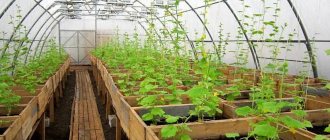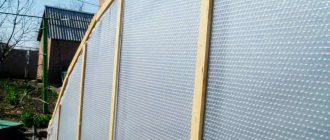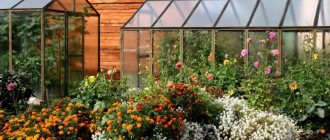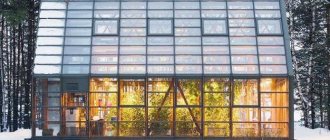Preparing the greenhouse in the spring for the new season
Immediately after the onset of the first warm days in the greenhouse, active work begins on growing vegetable crops in it. You should start by thoroughly washing and treating the walls inside and out. Do this with warm water with the addition of detergent. Do not use chemicals for washing. If some dirt is not removed immediately, wet it and wash it off after a while. The dirt particles will then be washed away.
IMPORTANT! Do not use hard brushes or sponges to wash walls, as they can damage the protective layer of polycarbonate.
After washing, the walls are treated with a disinfectant lime solution ( 500 g per 10 l). Disinfection is necessary not only for walls, but also for soil.
It is spilled with a solution of copper sulfate . You can also use garden lime, spreading 50 g per square meter. Alternatively, you can pour boiling water over the beds, then ventilate the greenhouse and dry the soil.
As experienced gardeners advise, it is better to remove a layer of soil of about 7 centimeters - a large number of fungi and pests accumulate in it, so this can get rid of many problems.
If it is not possible to replace the soil, it is recommended to treat it with disinfecting biological products, which have been widely available on sale recently. In addition to disinfection, such preparations also help increase soil fertility. They fix nitrogen in it, deactivate heavy metals, and promote the decomposition of pesticides remaining in the soil . After treatment with biological products, ventilation of the greenhouse is not required and you can immediately begin work in it.
Spring greenhouse maintenance also includes inspection of supporting structures. The wooden frame is checked for rotting of individual elements , the metal frame is checked for the presence of areas with corrosion. All unusable elements must be removed or secured.
ATTENTION! Paint over parts of the metal frame that show traces of rust with anti-rust paint.
To increase soil fertility in the spring, it is recommended to add compost and leaf mixture . Loosening is helped by adding peat and sand. After adding these elements, the soil is dug up.
Greenhouses can be made of different materials and have different equipment. On our website you will find a lot of useful information about a variety of designs. Read all about Dutch greenhouses, Chinese vegetarians and thermos greenhouses.
The design of a winter greenhouse and its difference from a summer one
A winter greenhouse has the main advantage - it is suitable for growing crops all year round. In fact, this is a capital structure, where a foundation must be built. The building is able to withstand heavy loads from winds and snow cover and can be constructed as a free-standing object or with one blank wall (as an extension to the house).
The basis of a winter greenhouse consists of 4 main elements:
- foundation. The most popular is the tape type, sometimes slab or columnar is used. Comprehensive insulation must be carried out to prevent further heat loss;
- frame. It may differ in shape - it all depends on local climatic conditions, as well as the preferences of the future owner. It is possible to build an arched, single- or double-sloped structure. The first option is considered the most popular; it is comfortable and can withstand loads well;
- sheathing The use of cellular polycarbonate is recognized as the most reliable and quite economical. The material has one of the best thermal conductivity indicators, maintains the temperature atmosphere inside, transmits light and does not allow harmful UV radiation to pass through. In winter types of greenhouses, sheets of material of medium and large thickness (from 10 to 20 mm) are used;
- communications. Heating, lighting, ventilation, organization of watering - these are four mandatory parameters that must be maintained in a winter greenhouse. There are many ways to achieve the goal, including lamps that generate the desired spectrum, laying a water supply system or installing special drinking bowls. In general, it all depends on the needs of the particular crop that the owner intends to grow.
Soil care
Growing various crops inside a greenhouse leads to its complete depletion during the summer season. Therefore, before starting to grow the next batch of plants, the soil should be enriched with minerals and microorganisms.
Adding humus and complex mineral fertilizers to the soil copes well with this task . Humus contains a lot of minerals necessary for plant development. Along with it, nutritional microorganisms enter the soil. It also makes the soil loose, air- and water-permeable.
But you should not add too much humus - the roots of the plant will begin to dry out, or the leaf mass will begin to grow to the detriment of fruiting.
Turf soil containing a large number of rotted roots of grasses and trees is also useful for plants. This composition helps to increase moisture absorption and saturation with nutrients.
To harvest turf, the top layer is first removed, then laid in stacks and sprinkled with lime. Laying height 1.5 meters. Humus is poured between the turf layers. During the ripening process, the turf is watered with slurry and periodically replanted.
ADVICE! Turf soil should be harvested in fields and meadows. You should not take one that is located next to swampy areas, since the soil there is too acidic.
Stove heating
The stove heating option is especially popular among summer residents, as it can warm up greenhouse premises in any climatic conditions. The stoves are placed in the coldest part of the greenhouse (vestibule, extension, on the north side), and the heated air is distributed depending on the area of the room - by natural convection, fans or by extending air ducts. The fuel used is firewood, coal, branches, peat, wood processing waste.
Advantages of stove heating:
- the oven starts quickly and the room heats up;
- fuel is inexpensive;
- ease of installation and operation of furnaces;
- the opportunity to make a stove on your own, using folk resources (scrap metal, used bricks).
As for the disadvantages, this is, first of all, the inability to automate stove heating. For safety reasons, when firing the stove, you must constantly be present in the greenhouse room, and this is not very convenient, especially if the region is northern, the winters are cold and you need to heat it from morning to night. Stoves of various designs are used to heat greenhouses. Let's look at the most popular options.
Buleryan stove
This stove can be called an improved potbelly stove. Buleryan is produced in industrial production; it is very difficult to make such a stove yourself. Its distinctive feature is hollow pipes mounted inside the structure and ensuring constant circulation of air masses. Cold air comes from below, then it passes through the oven and the output is not hot, but warm, not burning the plants. The buleryan stove is characterized by high efficiency, but heat transfer occurs only during combustion. A few more advantages of such a stove:
- it is quite compact;
- consumes little fuel;
- It is possible to connect air ducts or a water circuit to the Buleryan stove and deliver heat to distant parts of the room.
Brick oven
A brick stove is not just a heating element, but a full-fledged capital structure. With such heating, a polycarbonate greenhouse can be used all year round. The size and shape of the oven may vary depending on the area of the greenhouse. Brick ovens have a high heat capacity; they maintain the temperature throughout the day. That is why this option is often used for constant heating of winter greenhouses.
The heat in the room is distributed evenly and gradually, while brick stoves operate with low fuel consumption (wood). It is enough to heat the stove once a day, as a rule, this is done in the evening, and the air will be warmed up until the morning. And during the day, the greenhouse will be additionally heated thanks to solar energy. Among the disadvantages of brick kilns, it is worth noting their high cost. To lay such a stove, you first need to build a foundation in a greenhouse, and then invite a professional stove maker (you may not be able to do it yourself, as you need special skills).
Potbelly stove
A potbelly stove is the simplest option for stove heating of greenhouses. The design is simple: a metal container, a straight chimney, a compartment for storing fuel (this is the combustion chamber) and at the bottom a compartment for removing ash. When the wood inside the stove burns, its walls heat up and release heat into the room.
The positive aspects of such heating:
- simplest design, many summer residents make potbelly stoves themselves;
- Any type of fuel is suitable for heating;
- the room warms up quickly.
Among the disadvantages, it is worth noting rapid cooling and uneven heating of the room.
Also, a potbelly stove requires a large amount of fuel and dries out the air space in the greenhouse. Date: September 25, 2022
Is it necessary to add snow to the greenhouse in winter?
Why put snow in a greenhouse? An important measure to preserve the nutritional value of the soil is to preserve it from deep freezing during winter frosts. The open ground is protected from freezing by the snow cover, but snow does not fall into the greenhouse in winter. This means that it needs to be placed there mechanically. We need snow in the greenhouse! When it melts, it will moisten the soil and prepare it for planting.
Before throwing snow into the greenhouse, it is advisable to carry out autumn disinfection treatment so that diseases and pests do not survive under the snow cushion.
ATTENTION! Do not place snowdrifts inside the greenhouse; a small layer covering the surface is sufficient. If there is too much snow in the greenhouse, planting will be delayed until the soil dries out.
However, the attitude towards packing snow into a greenhouse is not clear-cut. Some experienced gardeners believe that this is not necessary, since snow delays the time for warming up the soil in the greenhouse.
In this video you will see how and how much snow experienced summer residents pour into a greenhouse in winter:
It is not advisable to throw snow indoors if groundwater is close to your site. In this case, an impassable swamp will form in the greenhouse, and you will not be able to plant plants in it for a long time.
Useful tips from Krovelson
- For temporary heating, you can use a bucket of hot coals. It is installed on a brick inside the greenhouse, which is also a good conductor of heat and retains it for a long time. There is another “grandmother’s” method - a kerosene lamp between two bricks, covered with a metal bucket.
- When choosing a greenhouse, the future owner must clearly understand its purpose: what crops will be grown there, how the greenhouse will be used (all year round or only during the summer season). It is necessary to decide on the area and location of the beds inside in order to achieve a more effective use of the greenhouse.
- Before installation, it is important to understand whether additional communications will be carried out inside. If the structure is planned to be made solid, then all work on installing heating, watering, and ventilation must be carried out in a timely manner in order to avoid future alterations.
- The design of the greenhouse must be suitable for the local climate. In regions with heavy precipitation (snow), pitched greenhouses are most often installed so that snow does not accumulate on the roof, but simply comes off it without consequences, without creating stress on the frame and preventing deformation.
- We are always ready to help clients and choose the optimal solution, advise on the choice of materials, and find an option that fits the required budget. We have high-quality products from the manufacturer and modern types of structures that will serve their owners for a long period and will not require repair work.
Warming up the soil
The final preparatory stage of spring preparation is warming up the soil .
Seedlings cannot be placed in unheated soil; they will begin to hurt and take root poorly, which will certainly affect the harvest. It’s good if there are warm beds in the greenhouse.
Rapid heating is facilitated by digging up the soil so that it receives heat from the air as quickly as possible.
You can also spill the soil with warm water . Covering the soil with black film is also effective . It is under these conditions that the temperature in the soil rises, and it will quickly be ready for planting.
If possible, you can place heaters in the greenhouse for several days. These can be either infrared heaters or any other heating systems. Read about what a heated greenhouse is in this article.
In addition to watering and heating the greenhouse, it is very important to choose the right equipment. Read useful materials about the drip irrigation system and the organization of ventilation.
How to heat a greenhouse: types of heating systems and design methods
The main difference between a winter greenhouse and a regular one is the presence of a heating system. There are several ways:
- The oven is the simplest and most traditional method. A stove is installed inside, which can be heated with ordinary wood, pellets, or peat. It is considered the most economical and easy method, but the main problem is the strong heating of the walls, so nothing can be planted around the stove - the plants will simply dry out and die.
- Infrared heater. Mainly located on the ceiling, it provides an average temperature inside of 21 ° C, and the soil - 28 ° C.
- Electrical appliances. Some owners prefer to use conventional heaters, but this method is ineffective due to the high energy consumption.
- Special heating systems. Modern developers offer new heating methods: they use a system similar to underfloor heating, which is installed in many homes. This solution requires a serious professional approach and special installation skills. But the result is the creation of a comfortable climate inside: the air does not dry out, there is no burning of oxygen, there is practically no chance of burns on plants, good heating is ensured and electricity costs are reduced.
How to properly clean polycarbonate
Regular 72% laundry soap with neutral pH is used as a cleaning solution for care. How to wash a polycarbonate greenhouse in autumn or spring? To prepare a concentrated cleaning solution, the soap is grated on a coarse grater. ½ piece per 10-15 liters of water, infuse overnight. Before use, the solution must be mixed thoroughly. If necessary, you can use it in small portions, diluting it with additional water.
A flannel cloth is used as a gentle cleaning agent. Before washing the greenhouse in the fall, you must thoroughly hose it down with water. This is done so that all the dried dirt becomes limp.
Particular attention should be paid to caring for the joints between the polycarbonate sheets and the greenhouse frame. Any green deposits that appear there should be washed thoroughly. It is in such places that late blight spores persist after general disinfection. When removing mold, you can use soft brushes (you can take an old toothbrush).
A small retreat
If we talk about the strength of such a structure as a greenhouse, then it would be correct to take care of this at the installation stage, to pay close attention to the presence of reliable fastening elements of the structure and the fastening elements of the roof itself. Since the larger the clamping area, the less traumatic the fastening will be for the structure of the frame covering; the more integral it is, the less the frame will be susceptible to the destructive effects of the environment.
But this article is not about that. He will touch on questions that concern many gardeners who grow and maintain vegetables in their summer cottages: is it necessary to strengthen the frame for the winter and how does the greenhouse withstand the winter? After all, not many people have the opportunity to visit dacha plots in winter, and the harsh Russian climate often cuts off all access roads to dacha plots. Therefore, structures left unattended require certain preparations for winter, so that at the beginning of the new season the owners do not have to worry more about restoring the greenhouse structure.
What is not recommended to do
Unlike glass, polycarbonate is very sensitive to surface microdamage. The strong mechanical impact and abrasive properties of semi-dry mud or incorrectly selected detergents can matt the surface of the sheet, which will significantly reduce the intensity of penetration of sunlight. When caring for a polycarbonate greenhouse, it is recommended to refrain from the following actions:
- Use long-handled brushes and scrapers designed for cars for cleaning and maintenance;
- Use detergents with abrasive microparticles;
- Use aggressive, acid-containing household chemicals, including washing powders or car chemicals;
- When caring for summer, do not wash polycarbonate if it is heated by the sun, this can cause clouding of the material;
- In winter, remove ice from the surface of the greenhouse with scrapers.
2
FreshRemont.com











